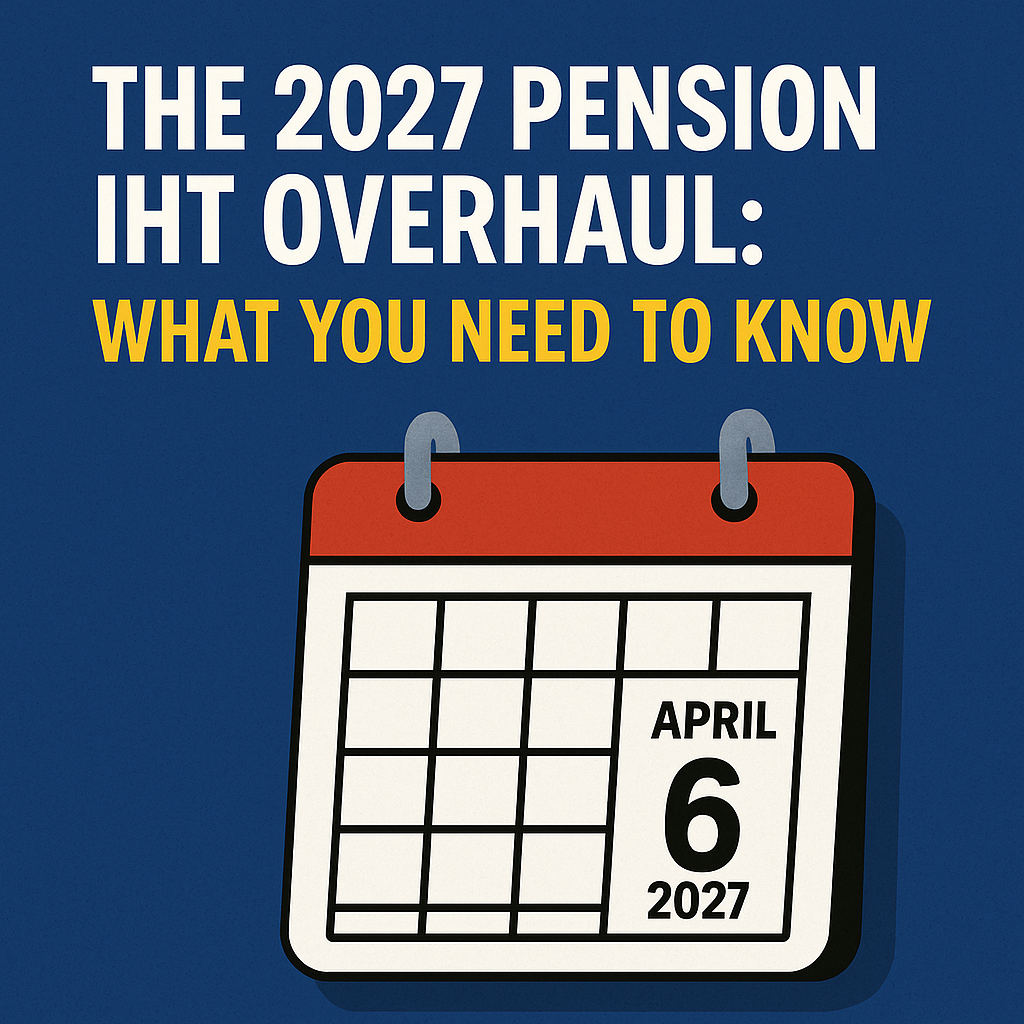
IHT on Pension from 2027
A massive change is coming to UK tax planning on 6 April 2027. After the Autumn Budget 2024 announcement, the government has confirmed that most unused pension funds will be dragged into Inheritance Tax (IHT) for the first time. This is probably the biggest shake-up in estate planning we’ve seen in decades, turning on its head a basic principle that’s guided retirement and legacy planning for years.
The government’s reasoning? They reckon pensions have increasingly become a clever way to dodge the 40% IHT charge rather than just funding retirement. This trend really picked up after Pension Freedoms in 2015 and scrapping the Lifetime Allowance in 2023, which made it quite attractive to leave pension pots untouched for beneficiaries. The new rules are designed to close this loophole and get pensions back to their original job: paying for retirement.
Now, before you panic – most estates still won’t pay any IHT. The government reckons that out of roughly 213,000 estates with pension wealth in 2027-28, around 10,500 will get hit with IHT where they wouldn’t have before, and another 38,500 will pay more than they would under the old system.
There’s some good news though. The government has kept some key exemptions. Most importantly, anything passed to a surviving spouse or civil partner remains completely free of IHT. And after plenty of industry moaning, they’ve decided that lump sum death-in-service benefits will stay out of IHT’s reach – a huge relief for millions of employees.
Here’s a quick summary of what’s changing:
Key Changes: Before vs After 6 April 2027
| What | Before 6 April 2027 | From 6 April 2027 |
|---|---|---|
| IHT on Unused DC Pensions | Generally sits outside the estate and is IHT-free | Gets lumped in with the estate and potentially liable for 40% IHT |
| Discretionary Trusts | The trustees’ discretionary power keeps pension funds outside the estate | Discretion no longer matters – funds are in the estate regardless |
| Who Pays the IHT | Wasn’t usually relevant as no IHT was due | Estate’s Personal Representatives take primary responsibility |
| Death-in-Service Benefits | IHT-free if paid via discretionary trust | Stays completely outside IHT, regardless of scheme type |
| Planning Strategy | “Spend other assets first, keep pensions last” was standard | This approach needs completely rethinking due to potential 40% IHT hit |
How Things Work Now (Until April 2027)
To understand why this change is so significant, you need to grasp how good the current system is for passing on wealth. The current setup has evolved through various policy changes rather than being deliberately designed, creating a strong incentive to use pensions purely for wealth transfer – exactly what the new rules aim to stop.
The IHT Exemption and Discretionary Trusts
Right now, most Defined Contribution (DC) pensions – SIPPs, personal pensions, workplace schemes – aren’t considered part of someone’s estate for IHT purposes.
This works because of how pension schemes are legally structured. Most modern schemes are discretionary trusts. When you fill out an “Expression of Wish” form, you’re not legally dictating who gets your pension money. You’re just giving guidance to the pension trustees or administrators. The final decision legally rests with them. Since you don’t have absolute control over where the money goes when you die, the pension pot doesn’t form part of your legal estate and therefore dodges IHT.
This is different from the rare “Direction” cases, where scheme rules let you give legally binding instructions. In these cases, because discretion is removed, the pension funds are considered part of the estate and liable for IHT even now.
Tax Treatment on Death
Whilst pensions currently avoid IHT, they’re not entirely tax-free on death. The treatment depends on your age when you die:
Death Before Age 75: Your beneficiaries can typically withdraw the pension funds completely tax-free. However, this is subject to your available Lump Sum and Death Benefit Allowance (LSDBA) of £1,073,100, reduced by any tax-free cash you took during your lifetime. Anything above this gets taxed at the beneficiary’s marginal income tax rate.
Death At or After Age 75: The IHT exemption still applies, but any funds withdrawn by beneficiaries get taxed at their marginal income tax rate – so 40% for higher-rate taxpayers.
Defined Benefit Schemes
DB (final salary) schemes work differently. On death, they typically provide a dependant’s pension for surviving spouses or eligible children. This is taxable income for the recipient, not a lump sum. Some DB schemes may pay lump sum death benefits, particularly for death in service. Under current rules, if paid at trustees’ discretion, these are typically IHT-free.
The New Rules from 6 April 2027: What Changes
The new system scraps the discretionary trust exemption entirely. The value of most unused pension funds and associated death benefits will be included in your estate for IHT purposes, regardless of whether pension trustees have discretion.
What Gets Hit by IHT
From April 2027, these pension assets will be added to your other assets when calculating your estate for IHT:
- Unused DC Scheme Funds: The main target – remaining value in all personal pensions, SIPPs, and workplace DC schemes
- Inherited Drawdown Funds: If you inherited funds from someone else and hold them in drawdown, they’ll be included in your own estate when you die
- Illiquid Pension Assets: Anything held within a pension wrapper, including commercial property or unlisted shares in SIPPs. This creates a real headache as it can create large IHT bills without providing cash to pay them
- DB Lump Sum Death Benefits: One-off lump sums from DB schemes (except death-in-service benefits)
- Unauthorised Payments: Any unauthorised payments from deceased members’ pension funds
What Stays Out of IHT
After industry consultation raised serious concerns, the government made several important concessions:
- Death-in-Service Benefits: All lump sum death-in-service benefits from registered pension schemes remain IHT-free, whether discretionary or not
- Dependant’s Scheme Pensions: Continuing pensions to dependants from DB arrangements
- Joint Life Annuities: Income payments continuing to surviving annuitants
- Trivial Commutation Benefits: Small lump sums under £30,000 from dependant’s pensions
What’s In and Out of Scope
| IN SCOPE for IHT | OUT OF SCOPE |
|---|---|
| Unused DC pension funds | Death-in-service benefits |
| Beneficiary drawdown accounts | DB dependant’s pensions |
| DB lump sum death benefits (not death-in-service) | Joint life annuity survivor benefits |
| Illiquid pension assets | Trivial commutation benefits |
| Unauthorised payments |
The Exemptions That Still Matter
Two fundamental IHT exemptions remain and will apply to pension wealth:
Spousal/Civil Partner Exemption: Anything passed to a surviving spouse or civil partner remains completely IHT-free. This is now the most important exemption in pension planning.
Charity Exemption: Pension funds left directly to registered charities will be IHT-free.
The spousal exemption creates a sharp difference in outcomes between married and unmarried couples. Previously, an unmarried person could leave their pension to children IHT-free. From 2027, this won’t be possible, making the tax consequences dramatically different and more severe for unmarried partners or those wanting to pass wealth directly to children on first death.
How the New System Will Work
One of the trickiest aspects is the new administrative process. The government initially wanted Pension Scheme Administrators to handle the IHT, but industry opposition was fierce due to practical difficulties. They’ve now reversed this decision.
Personal Representatives Take Charge
Primary responsibility now falls on the Personal Representatives (PRs) of the estate – typically the executors named in the will. This aligns with how IHT works for other assets, but places a significant burden on PRs, who are often grieving family members with no tax administration experience.
This creates potential liability, complexity, and tight deadlines. PRs are caught between HMRC’s strict 6-month payment deadline, the challenge of valuing multiple pension schemes, and the risk that the main estate lacks liquid cash to pay the pension-related tax bill.
The New Process
A formal information-sharing framework will require cooperation between PRs, Pension Scheme Administrators, and beneficiaries:
- Notification: PRs identify all pension schemes and notify administrators of the death
- Valuation: Administrators provide pension values within four weeks
- Calculation: PRs calculate total estate value and overall IHT liability
- Communication: PRs inform beneficiaries and administrators of IHT amounts
- Payment: IHT must be paid within six months to avoid interest charges
Payment Options
To address liquidity concerns, three payment routes will be available:
Pay from the Estate: PRs pay the full IHT bill from liquid estate assets, then recover the pension portion from beneficiaries.
Pensions IHT Payment Scheme: Beneficiaries can direct administrators to pay their IHT share directly to HMRC from inherited pension pots (mandatory for benefits over £4,000).
Beneficiary Pays Direct: Beneficiaries receive full benefits, pay any income tax, then settle IHT liability themselves. They may claim income tax refunds on amounts used for IHT.
Roles and Responsibilities
| Who | What They Do |
|---|---|
| Personal Representative | Identify schemes, notify administrators, calculate IHT, submit returns, manage payment deadlines, recover tax from beneficiaries |
| Pension Administrator | Provide valuations within 4 weeks, operate payment scheme for benefits over £4,000, pay IHT on beneficiary direction |
| Beneficiary | Become liable for IHT on their share, choose payment method, liaise with PR and administrator |
Real-World Impact: What This Means in Practice
Let’s look at some examples to see how this plays out in real life.
Case Study: Susan’s Story
Susan is a widow with a £1.2 million estate: £700,000 family home and £500,000 SIPP. She wants to leave everything to her two adult children.
Death Before 6 April 2027:
- SIPP passes IHT-free outside the estate
- Estate for IHT purposes: £700,000 (just the home)
- Using her own and her late husband’s allowances: £1 million threshold
- IHT bill: £0 (estate under threshold)
Death After 6 April 2027:
- SIPP now included in estate
- Total estate for IHT: £1.2 million
- Threshold still £1 million
- Taxable amount: £200,000
- IHT bill: £80,000 (40% of £200,000)
A common scenario creating an £80,000 tax bill that didn’t exist before.
The Double Tax Trap
Perhaps the nastiest consequence is potential double taxation when the deceased is over 75. The fund gets hit with IHT first, then beneficiaries pay income tax on what’s left.
Take a £100,000 pension pot inherited from someone who died after 75, with the beneficiary being a 40% taxpayer:
- IHT: 40% of £100,000 = £40,000
- Remaining fund: £60,000
- Income tax on withdrawal: 40% of £60,000 = £24,000
- Total tax: £64,000
- Beneficiary receives: £36,000
That’s an effective 64% tax rate on the inherited pension.
The RNRB Taper Trap
There’s a hidden sting involving the Residence Nil-Rate Band (RNRB) – an extra £175,000 IHT allowance for passing homes to direct descendants. This gets tapered away for larger estates, reducing by £1 for every £2 the estate exceeds £2 million.
Including large pension pots can easily push estates over this threshold, wiping out tax relief on the family home.
Consider an estate with a £1.3 million property, £600,000 other assets, and a £700,000 pension:
Before 2027: Estate value £1.9 million (below £2 million threshold), so full £175,000 RNRB available.
After 2027: Total estate £2.6 million (£600,000 over threshold), so RNRB completely eliminated.
Result: Pay 40% IHT on the pension AND lose £175,000 tax-free allowance on the property, creating additional £70,000 IHT that wouldn’t otherwise be due.
Planning Strategies for the New World
These changes require completely rethinking traditional estate planning. The window until April 2027 offers a crucial opportunity to review arrangements and take action.
Rethinking “Pensions Last”
The long-held wisdom of spending ISAs first and preserving IHT-free pensions is now questionable. For estates likely to face IHT, it may become more efficient to draw down pensions during lifetime, paying income tax at marginal rates (20% or 40%), rather than leaving the pot to suffer 40% IHT on death. This preserves fully IHT-free assets like ISAs for beneficiaries.
Spousal Exemption is King
For married couples and civil partners, the spousal exemption becomes the most powerful pension planning tool. The default strategy will often be ensuring all pension funds go to the surviving spouse, as this transfer is completely IHT-free. This defers IHT liability until the second death, providing time for further planning.
Review Beneficiary Nominations
It’s now crucial to review and update “Expression of Wish” forms with all pension providers. Whilst these no longer provide IHT protection, they’re vital for ensuring the right people inherit funds. Out-of-date nominations could lead to assets passing to ex-spouses or non-exempt beneficiaries, triggering unexpected IHT charges.
Lifetime Gifting and Trusts
To reduce overall estate value, consider accelerating lifetime gifting plans. Using annual gift allowances and making Potentially Exempt Transfers (IHT-free if you survive seven years) can reduce the non-pension estate, creating headroom within IHT thresholds. Trusts can also be effective for holding other assets.
Ensure Estate Liquidity
Make sure the non-pension estate has sufficient liquid assets to cover potential IHT bills. This avoids situations where PRs must sell family homes or wait for beneficiaries to access pension pots to pay tax. Life insurance written into trust to cover projected IHT liability is a classic and now highly relevant strategy.
Business Owners Beware
Business owners holding commercial premises within pensions need specialist advice urgently. The new rules could create scenarios where estates face large IHT bills on property values, but PRs have no access to the property itself to pay tax. This could force fire sales of premises, jeopardising business futures.
Common Questions
Will my final salary pension be subject to IHT after 2027? The regular dependant’s pension to surviving spouses is exempt and treated as their taxable income. However, one-off lump sum death benefits (other than death-in-service) are expected to be included and may face IHT.
Are death-in-service benefits still IHT-free? Yes. The government has explicitly confirmed these remain completely outside IHT scope.
What if my estate lacks cash for pension IHT? Beneficiaries can ask pension companies to pay their IHT share directly to HMRC from inherited pots. Without this, PRs may need loans against estate assets or forced sales of property like family homes.
Does spousal exemption still apply? Absolutely. This is one of the most important continuing exemptions. Pension funds can pass to surviving spouses or civil partners completely IHT-free.
How do new IHT rules interact with the LSDBA? They’re separate frameworks that can apply to the same money. LSDBA is an income tax allowance limiting tax-free lump sums on death before 75. The new rules introduce 40% IHT on pension pot values. Both could potentially apply.
I live abroad – do UK rules still affect my UK pension? Yes. UK pensions are UK-situated assets, so values will be included in your estate for UK IHT from April 2027, regardless of where you live.
Should I take more money out of my pension now? This is complex with no universal answer. Taking money out during lifetime triggers income tax at your marginal rate. Whether this beats potential 40% IHT on death depends entirely on your circumstances, including age, health, income position, other asset values, and legacy goals. This requires sophisticated modelling and professional advice.
Getting Help
The pension inheritance landscape has been completely redrawn. The end of IHT-free pensions, combined with new administrative burdens and severe double taxation risks, means old assumptions are dead.
Generic solutions or doing nothing could leave your loved ones with unexpected tax bills, administrative delays, and unnecessary stress during difficult times. Effective planning now demands a comprehensive strategy considering your pension, property, other investments, and ultimate legacy wishes.
These rule changes are significant, but with proper guidance, you can stay in control of your financial future.










Write a comment: